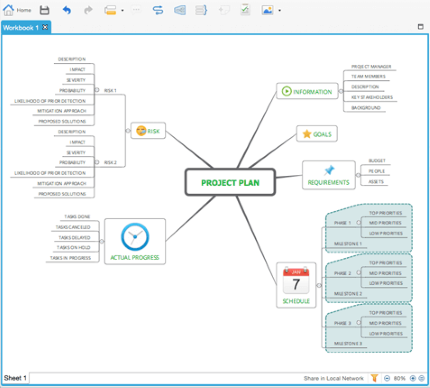A proficient carpenter uses a set of tools to create frames for new houses, install kitchen furniture and do other important work to make the house of your dream. Building an e-Learning course is just like constructing a house: The right choice of tools determines the final result, and actually the future life of the people living in that house.
Course authors, professional business trainers, and teachers use certain tools to develop courses and deliver them to end users. In this article you will learn about top e-Learning tools that will help you master your online teaching.
1 – Picture your idea with XMind
A clear plan that helps envision and develop your idea is the first key to building a successful course. Our brain works like a net and actively uses associations. With XMind you can build a chart that pictures your idea as it is. You just draw what’s on your mind.
Don’t forget about essential tools from the real world: a piece of paper and a pen. All great ideas start on paper. It’s also important to take pictures of your writings and drawings to keep them safe. Use a camera on your smartphone to save your sketches and keep them organized.
2 – Make notes with Evernote
Creating a course always involves a lot of planning, which is often based on interaction with other people or departments within your organization. Use Evernote to create plans and to-do lists, and share them with colleagues. You can also make notes on images. Everything is stored in the cloud, so it’s available everywhere and on any device.
3 – Edit your graphics with Paint.NET
Every effective course should have creative and captivating images in it. Even if you are not a painter or designer, you have to work with images throughout the course creation. If you are not planning to spend over a thousand dollars on Photoshop, that’s fine, because you can use its free alternative, Paint.NET.
Use it for processing screenshots and other tasks. Similar to Photoshop, it allows you to work with layers, add text and draw objects. You can then save images in .png with transparency.
4 – Author your e-Learning content with iSpring Suite
Eventually, you’ll need an authoring tool to create a course. It will be the core of your online learning bundle. There are many tools on the market, and this one doesn’t require any additional training. With iSpring Suite, you can turn your PowerPoint presentations into professional training courses with tests, video narrations, screencasts, and interactive elements. iSpring HTML5 conversion technology preserves all the effects from your original .pptx file including transitions, complex animations, and triggers.
With the built-in QuizMaker tool, you can create complex assessments with up to 11 graded question types, plus utilize branching features and advanced scoring options.
5 – Capture your screen with Camtasia
Use Camtasia for recording screen capture if you need some sort of descriptive video in your course. Not every course contains video capture or software simulations; however, they can make it more vivid and descriptive. Ask yourself: does anyone from your learners prefer video tutorials to written instructions?
As the founder of Khan Academy has said, video education has turned out to be more effective than face to face tutoring.
6 – Insert interactions and gamification elements by Raptivity
Gamification, one of the hottest recent trends in e-Learning, has proved to be an effective way to engage learners with course material by challenging them to win. It is important to keep the learner’s attention throughout the course, and interactive features will help you achieve this. The library of various interactions is provided by Raptivity and available on their website.
7 – Quickly share your content in the Dropbox / Google Drive
If you need to share your projects and all supplementary files with colleagues or a vast audience, you can use a simple solution like Dropbox. Put all your projects and documents in the cloud and use it for preview, share or promotional campaigns.
Google Drive will provide up to 10 GB of free space to store your documents and undoubtedly cool online document editing tools. Google Drive is the best place for collaborative work with its real-time suggestions and comments, synced among all participants.
8 – Use Litmos as your LMS
If you’re planning to run complex teaching, register students, assess them online and manage the rest of the educational process, you will need a fully functional LMS. It will automatically track learners’ activity and provide a complete set of reports, analyze the effectiveness of your training, and monitor your sales activity (SalesForce integration).
Litmos is one of the easiest to use LMSes on the market. The system is good for employee learning, customer training, compliance training, etc. It features simple and powerful dashboard, versatile feature list necessary for online teaching. Plus, your learners will get the free app for iPad and Android, which will be their gateway to the courses in your Litmos account.
9 – Skype / GoToMeeting for hosting live lectures or online meetings
Talk to your students face to face. Use Skype or Citrix GoToMeeting to host online meetings during the course development stage, or even to lecture online. This will literally create the 21st century classroom, where everybody is learning from their homes.
10 – Run website or blog to connect with your learners: WordPress / Blogpost
Run your own blog to promote your courses and share your ideas and knowledge. Needless to say that blog requires constant work, but it will be a huge advantage to your marketing campaigns. Use social networks to promote your courses and give your vast audience a quick preview of what’s available at a glance.
The most popular ones are Facebook and Twitter; they will effectively work along with your blog. If used well, this strategy usually doubles the traffic that goes to your personal website.
Conclusion
We hope that these 10 various e-Learning tools will help you create beautiful and professional courses, deliver them to your learners, and track their effectiveness (both of learners and courses). If you actively use a tool that’s not on the list, or if you have any other suggestions on using the above-mentioned tools, please share your experience in the comments below.











